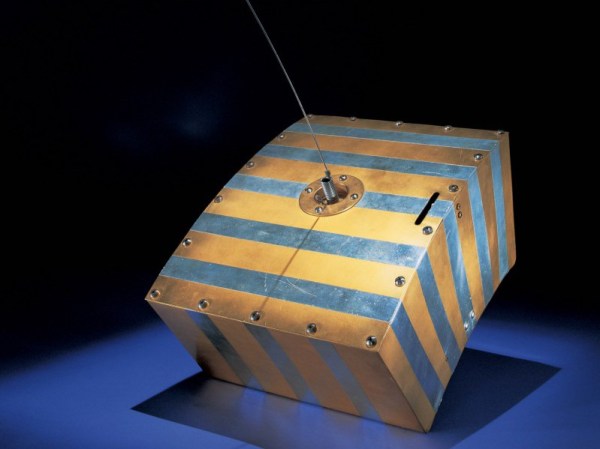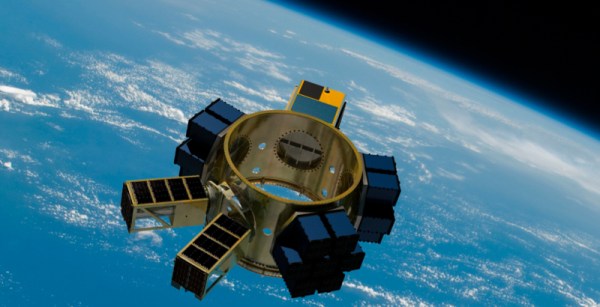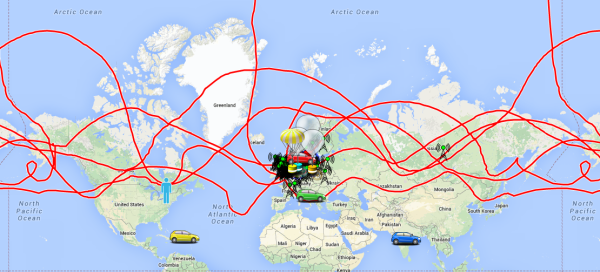In early December 1961, a United States Air Force rocket took off from Vandenberg Air Force Base in California carrying a special payload. The main payload was a Corona surveillance satellite, but tucked just aft of that spacecraft was a tiny package of homebrew electronics stuffed into something the looked like a slice of cake. What was in that package and how it came to tag along on a top-secret military mission is the story of OSCAR 1, the world’s first amateur radio satellite.
Original Hackers’ New Satellite In Orbit
Ham radio put another satellite in orbit, the FOX-1A. Not many groups have the long-term hacking credentials of hams. Their tradition extends back to the first days of radio communications, which puts the group well over a century old. This newest satellite launched in the early hours of October 8th and, after deployment, was heard later the same day. Anyone with the ability to listen on the 2m band can hear FOX-1A. T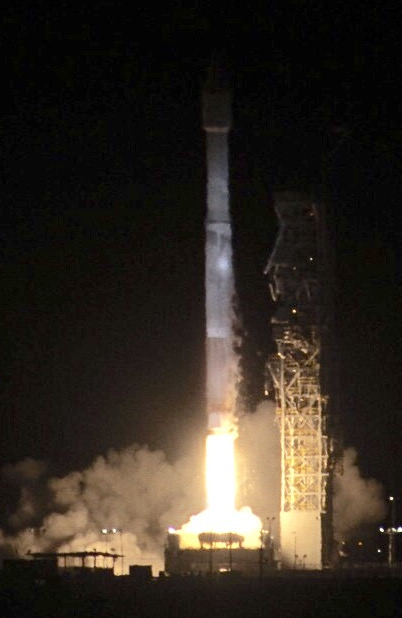 hose licensed as hams will be able to communicate using a 70cm transmitter while listening on 2m.
hose licensed as hams will be able to communicate using a 70cm transmitter while listening on 2m.
This satellite is using the cube-sat format and ‘ride sharing’ through a program offered by NASA and the National Reconnaissance Office (NRO). Twelve other nano-satellites rode along with the FOX-1A. These 10 cm cubes are used for commercial, educational, and non-profit projects. The purpose of today’s satellites covered not only ham radio but educating students in satellite construction, land management by American Indian tribes, and space to ground laser communication. Yeah, what’s cooler than space lasers? Video about the FOX-1A after the break.
We’ve seen some interesting ideas for cube-sats. And if you want to think about the ground portion of a system like this, check out the SatNOGs story — winners of the 2014 Hackaday Prize.
CubeSat Challenge Winners Show Interesting Design Approaches
The winners are in for the GrabCad CubeSat Challenge, which asked designers to rethink the way that CubeSats are built. These tiny 10 cm square satellites are the hot thing in orbit, and the competition was looking for new ways to build and pack more into this tiny space. The winners offered some fascinating new approaches to building CubeSats, and some excellent design lessons that anyone can use.
The winner was FoldSat, by [Paolo Minetola]. His excellent design is a 3D printed folding case for a satellite that is built from just two 3D printed parts. The case can be snapped together and offers multiple ways to mount electronic components and sensors inside. [Paolo] estimates that it could save 40% time and 30% materials from existing CubeSat casings, which means more space inside and more time to build. It is an excellent example of how 3D printing can make things cheaper, easier and better, all at the same time.
Continue reading “CubeSat Challenge Winners Show Interesting Design Approaches”
High Altitude Balloon Keeps Going
Here’s a post from the AMSAT-UK high altitude balloon blog. It’s a great story about a balloon cruising at about 12km above the Earth completing its sixth circumnavigation of the planet. That post is from October 4th, and two weeks later the balloon is still going strong. Right now it’s over the Baltic heading into Russia with no sign of stopping or popping any time soon.
 The balloon was launched July 12, 2014 from Silverstone, UK. In the 100 days since then, this balloon has covered 144168 kilometers and has crossed its launching longitude six times. Even if this balloon weren’t trapped at high latitudes (including coming within 9 km of the pole), this balloon has still travelled more than three times the equatorial circumference of the Earth.
The balloon was launched July 12, 2014 from Silverstone, UK. In the 100 days since then, this balloon has covered 144168 kilometers and has crossed its launching longitude six times. Even if this balloon weren’t trapped at high latitudes (including coming within 9 km of the pole), this balloon has still travelled more than three times the equatorial circumference of the Earth.
The balloon was built by [Leo Bodnar] a.k.a. [M0XER] with a self-made plastic foil envelope. The solar-powered payload weighs only 11 grams. It’s an exceptional accomplishment and one that has smashed all the amateur high altitude balloon distance records we can find.
ISEE-3 Dream Team Needs Your Help
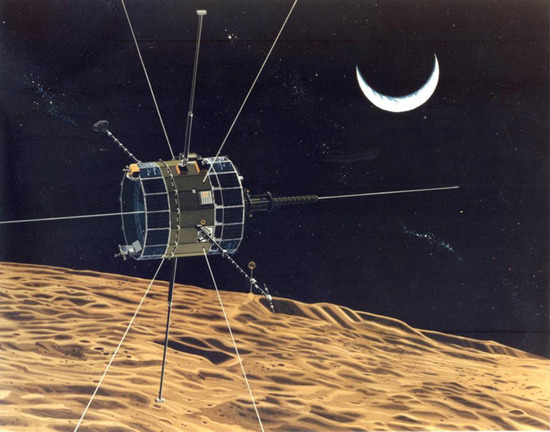
The mission to save ISEE-3 has is underway. The ISEE-3 Reboot Project has posted a crowdfunding campaign on Rockethub. When we first covered the ISEE-3 story no one had heard from it since 2008. Since then AMSAT-DL, an amateur radio group in Germany has received signals from the probe.
The ISEE-3 Reboot Project is being managed by [Dennis Wingo] and [Keith Cowing], the same two men who spearheaded the effort to recover NASA’s Lunar Orbiter images from old magnetic tapes. They did most of their work using restored 1960’s equipment in a vacant McDonald’s.
The goal of the ISEE Reboot Project is to return ISEE-3 to its original Earth/Sun Lagrange point L1 orbit. Once safely back in orbit, it will be used for STEM education, amateur radio solar predictions, and for science about the sun. In [Dennis Wingo’s] own words
If we can do this, we will have an open source, publicly accessible satellite data stream of the first open source satellite above Low Earth Orbit.
[Wingo] and [Cowing] aren’t alone in this effort; they are working with a venerable dream team. In addition to getting the nod from NASA, the team also has the help of [Dr. Robert Farquhar], the orbital dynamics guru who originally designed ISEE-3’s comet intercept orbit . [Farquhar] has an extremely personal reason to participate in this project. In 1982 he “borrowed” the satellite to go comet hunting. Once that mission was complete, he promised to give ISEE-3 back. [Dr. Farquhar] and his team designed the maneuvers required to bring ISEE-3 back to L1 orbit back in the 1980’s. This includes a breathtaking moon flyby at an altitude of less than 50 km. Seriously, we want to see this guy’s KSP missions.
Communicating with the ISEE-3 is going to take some serious power and antenna gain. The project has this in the form of a 21 meter dish at Moorehead State University in Kentucky, USA, and the Arecibo Observatory. Arecibo should be well-known to our readers by now. Moorehead and Arecibo have both received signals from ISEE-3. The reboot project team is also working directly with the AMSAT-DL team in Germany.
If this effort seems a bit rushed, that’s because time is very short. To implement [Dr. Farquhar’s] plan, ISEE-3 must fire its thrusters by late June 2014. In just two months the team needs to create software to implement ISEE-3’s communications protocols, obtain and install transmitters at Moorehead and Aricibo, and send some basic commands to the craft. Only then can they begin to ascertain ISEE-3’s overall health in preparation for a thruster burn.
If the ISEE-3 Reboot Project succeeds, we’ll have an accessible satellite well outside of low Earth orbit. If it fails, Issac Newton will remain at the helm. ISEE-3 will fly right past Earth, not to be seen again until August 2029.
ISEE-3: We Get Signal
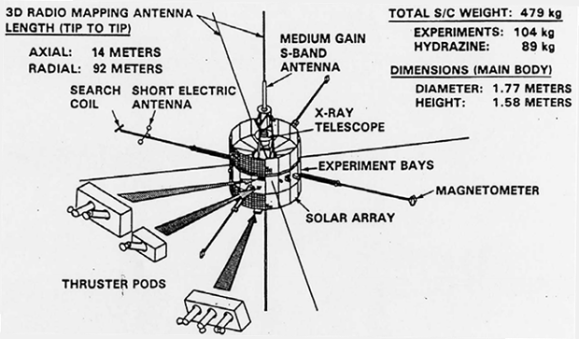
Out in the depths of space, more than 100 times the distance from the Earth to the moon, there’s a lonely spacecraft gracefully spinning towards an August encounter with our planet. It’s ICE/ISEE-3, a probe long-forgotten by official space agencies. Now, the team dedicated to repurposing this satellite has made contact with this probe using a 20-meter satellite dish in Germany.
When we first heard about the planned communication by volunteers, no one was certain the probe was still alive. It shouldn’t be a surprise this satellite was still functioning; it was launched in 1978, and most of the instruments were still functioning in 2008. Still, this is the first time amateurs – not NASA – had received a signal from the probe
ICEteam, the group of volunteers dedicated to reviving this spacecraft used the huge dish at Boshum observatory to detect the 5 Watt carrier signal coming from the spacecraft. That’s all the probe is sending out right now – no data was received – but this is a huge accomplishment and the first step towards directing ICE/ISEE-3 into an orbit around one of the Earth-Sun Lagrange points.
Side note: Looking at the ephemeris data (target -111) I *think* ICE/ISEE-3 will be above the night side of Earth at closest approach. Can anyone confirm that, and does that mean a future mission at L2?
Video from the ICEteam below.
Tracking Satellites With An Arduino

The guys over at brainwagon just finished up ANGST, the Arduino n’ Gameduinio Satellite Tracker, a build that displays 160 different satellites in Earth orbit on any SVGA monitor.
The build is of course based off an Arduino and Gameduino shield. A real-time clock is always needed for a satellite tracker, so a DS1307 RTC is thrown into the mix. The satellite data is stored on a 128KB EEPROM that is big enough to hold 750 different satellites and orbits.
The software side of things is a bit trickier. The guys at brainwagon used [James Miller]’s very popular and very old-school PLAN-13 sat tracking software. This orbit calculation program was published in 1983 and has since been ported from BBC Basic to just about every system imaginable.
Once the ANGST is hooked up and powered on, it reads the real-time clock and calculates the position of a satellite. This is done in real-time and updated every three minutes. On the screen, the last orbit (and a little more) is displayed along with the sun and the location of the ANGST. You might not find something like ANGST at the Space Command at NORAD, but we can’t think of a better way to keep track of the cubesats and spy sats above our heads.

